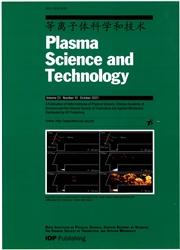靶腔内几百太瓦激光脉冲辐照固体目标电磁脉冲的时空演化
IF 1.8
3区 物理与天体物理
Q3 PHYSICS, FLUIDS & PLASMAS
引用次数: 0
摘要
高功率激光照射固体目标产生的巨电磁脉冲会干扰各种实验诊断甚至损坏设备,因此揭示激光腔内巨电磁脉冲的演变对于设计有效的电磁脉冲屏蔽装置至关重要。在这项工作中,利用b点探针研究了电磁脉冲的传输特性与靶室中心(TCC)距离的关系。在距离TCC 0.32 m、0.53 m、0.76 m和1 m处,皮秒激光与目标相互作用产生的平均EMP幅值分别为561 kV m-1、357 kV m-1、395 kV m-1和341 kV m-1,从0.32 m急剧减小到0.53 m。但在0.53 ~ 1 m范围内呈现波动。仿真和实验结果表明,电磁脉冲时域信号在靠近靶室壁面处的半最大全宽比靠近靶室壁面处的全宽宽大,这主要是由于靶室内电磁波的回波振荡造成的。本文的研究结果将为减少激光与目标耦合过程中靶腔内电磁波的回波振荡,减轻强电磁脉冲提供新的途径。本文章由计算机程序翻译,如有差异,请以英文原文为准。
Spatial and temporal evolution of electromagnetic pulses from solid target irradiated with multi-hundred-terawatt laser pulse inside target chamber
Abstract Giant electromagnetic pulses (EMPs) induced by high-power laser irradiating solid targets interfere with various experimental diagnoses and even damage equipment, so unveiling the evolution of EMPs inside the laser chamber is crucial for designing effective EMP shielding. In this work, the transmission characteristics of EMPs as a function of distances from the target chamber center (TCC) are studied using B-dot probes. The mean EMP amplitude generated by picosecond laser-target interaction reaches 561 kV m-1, 357 kV m-1, 395 kV m-1, and 341 kV m-1 at 0.32 m, 0.53 m, 0.76 m, and 1 m from TCC, which decreases dramatically from 0.32 m to 0.53 m. However, it shows a fluctuation from 0.53 m to 1 m. The temporal features of EMPs indicate that time-domain EMP signals near the target chamber wall have a wider full width at half maximum compared to that close to TCC, mainly due to the echo oscillation of electromagnetic waves inside the target chamber based on simulation and experimentation. The conclusions of this study will provide a new approach to mitigate strong electromagnetic pulses by decreasing the echo oscillation of electromagnetic waves inside the target chamber during laser coupling with targets.
求助全文
通过发布文献求助,成功后即可免费获取论文全文。
去求助
来源期刊

Plasma Science & Technology
物理-物理:流体与等离子体
CiteScore
3.10
自引率
11.80%
发文量
3773
审稿时长
3.8 months
期刊介绍:
PST assists in advancing plasma science and technology by reporting important, novel, helpful and thought-provoking progress in this strongly multidisciplinary and interdisciplinary field, in a timely manner.
A Publication of the Institute of Plasma Physics, Chinese Academy of Sciences and the Chinese Society of Theoretical and Applied Mechanics.
 求助内容:
求助内容: 应助结果提醒方式:
应助结果提醒方式:


